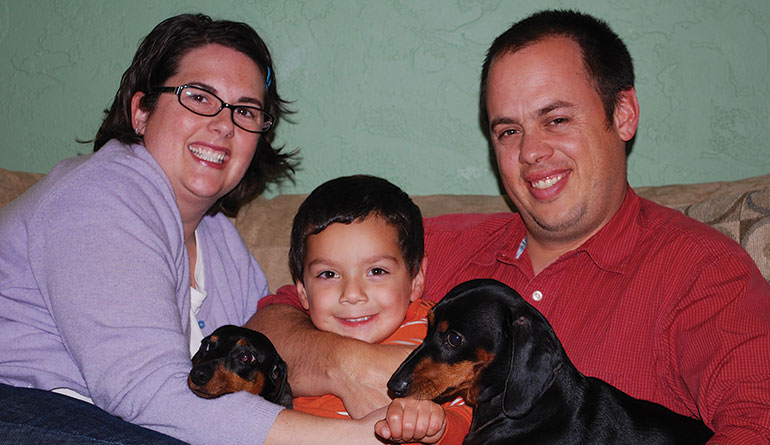Parents of newborns, whether through adoption or birth, can follow a mostly predictable pattern. When the baby cries, he’s hungry, needs a new diaper, or is tired. If in doubt about a child-rearing point, parents can turn to countless books and websites, as well as family and friends. And each time they meet their child’s need, parents reinforce a mutual attachment.
What happens, then, to children whose needs are not consistently met in their early months and years?
They become survivors, and they’re pretty amazing for it. But the parents who welcome these amazing kids into their families need to adapt their expectations. They won’t have readily available resources to teach them how to respond to situations they never dreamed they’d face. Here are some scenarios that parents encounter when adopting an older child (children ages two or older). Let’s see what may cause their surprising behaviors, and learn from parents and experts how to meet the child’s needs and build attachment. As they’ve found, there are many different ways to make a family work.
“He’s So Affectionate!”
When an older child joins a permanent family, he may hug a relative he’s just met or call all the new women in his life “Mama.”
- What’s going on: It’s easy to misread indiscriminate affection as friendliness or a sign that the child is primed to attach; experts warn that the opposite is true. In a foster home or an institutional setting, a child may have learned to endear himself to his caregivers. He may turn on the charm for everyone but his new parents, wary of the true intimacy he’d experience by placing trust in anyone. Now he needs to learn that his parents are in charge and will meet his needs, and that he doesn’t have to “curry favor” with them for that to happen.
- What parents can do: By “cocooning”—spending time with just your immediate family—for a period after your child comes home, he’ll have only his new parents to meet his needs and provide affection.
Your child must learn to depend on you, his new parents, says Mary Hopkins-Best, author of Toddler Adoption: The Weaver’s Craft. “A child cannot display healthy independence until he has experienced healthy dependence. Encouraging a newly adopted child’s apparent self-reliance is the most common problem I encounter in families.”
Of course, life doesn’t stop when you adopt your child—there are excited grandparents who want to visit, siblings who need to be driven to baseball practice, and a million other things pulling you away from cocooning time. If you can’t limit contact, at least let friends and relatives know that you should be the only ones to provide your child’s care (feeding, changing, bathing) for the time being.
AF reader Julie Smith* followed this advice after adopting a two-year-old boy from the U.S. foster system: “My husband and I limited who could pick up our son for the first six to eight months. We kept it to ourselves and his grandparents.”
If your child does not become more selective with his affection over time, cautions Gregory Keck, Ph.D., founder of the Attachment and Bonding Center of Ohio, you may want to seek professional counseling.
“She Doesn’t Want to Have Anything to Do with Dad.”
Tonya Todd’s daughter, adopted from Russia just before she turned three, attached very quickly to her mom, but not her dad. To encourage attachment, he focused on playtime and did not enforce any discipline for several months. Tonya would leave the two alone for only an hour or two in the beginning. While their bond is strong now, it took nearly a year before their daughter would turn to Dad to meet her needs.
- What’s going on: “It’s not unusual to have a stronger connection with the parent who does more of the parenting,” says Keck. However, some children attach more quickly to the parent who is filling a new role. Lisa McFarland, who adopted three children from the foster system, found that their daughter attached much more quickly with her husband. “She had never had a father figure in her life before,” she says.
- What parents can do: Diana Schwab, M.Ed., of International Adoption Health Services of Western Pennsylvania, in Pittsburgh, suggests that the unfavored parent take over nurturing care, like feeding, and that he play games that involve eye contact and connection.
Having the unfavored parent spend one-on-one time with the child can jump-start bonding. If your new son prefers Mom, it may be easier for Dad to take him on a fun outing rather than for Mom to leave the guys at home; in the latter scenario, the child may spend the whole time worrying about when Mom is coming back.
For McFarland, bonding with her daughter has been a slow but satisfying process. “Counseling has helped both of us understand that she never really learned how to have a mother/daughter relationship. Now I am able to see how much she really wants a mom to spend time with. We enjoy being together.”
“During the Day, It Seems He’s Adjusted Marvelously—But He Wakes Up Screaming at Night.”
Heather Finley’s son, adopted from China at nearly two years old, woke up crying, hitting, and kicking, sometimes a dozen times a night.
- What’s going on: Children who seem well-adjusted during the day may be holding in their feelings. These often come out as nightmares and night terrors. During a night terror a child may scream or thrash violently, and be difficult or impossible to calm, but he may not remember the episode the next day.
- What parents can do: Sit with your child through the episode, providing whatever comfort and reassurance you can. “We found that wiping our son’s face with a cool, damp washcloth seemed to shorten his night terrors,” says Hopkins-Best. “For some children, this is a rare time when they are not touch-resistant.”
“My husband and I decided to take turns sleeping with Henry in our bed, so that we could respond to him as soon as he started crying, before he started hitting,” says Finley. She would rub his stomach and reassure him that she was right next to him and he was safe. “It was tough on our own sleep patterns, but we knew that it was important to build his trust that we would be there for him.”
Of course, when your child isn’t sleeping, you’re not sleeping, and the resulting crankiness makes attachment tougher. “Adequate sleep is also crucial for brain development,” Keck reminds us. He recommends that parents talk to their pediatrician if sleep is interrupted for more than a few months.
Children adopted at older ages may have a variety of sleep problems, some of which are counterintuitive to parents. For instance, a typical two-year-old will whine and complain about going to sleep, but a two-year-old who has spent time in foster care may get into bed on his own, then rock himself to sleep. If this is the case, Patty Cogen, author of Parenting Your Internationally Adopted Child, encourages parents to create a bedtime ritual in which the child “needs” the parent in order to fall asleep. Hopkins-Best concurs: “Bedtime provides a wonderful opportunity for developing rituals that involve touch and nurturing. Whether that includes food, drink, or reading a story, the important thing is that the child looks to Mom and Dad as the providers.”
“She’s Hidden Food All Over the House and Often Eats Herself Sick.”
Parents adopting older children should expect some strange food behaviors at first. It’s common for children to hoard food, to constantly open the refrigerator door, and to consume enormous quantities at each meal.
- What’s going on: If a child has experienced hunger, it may take a long time for him to trust that his new family will provide enough food for him.
- What parents can do: Reassure your child that he will never go hungry again. You might say, “I know that you’re worried that you won’t have enough food and you’ll be hungry. I want you to know that we’ll always give you all the food that you need.” Reinforce this message concretely by allowing your child to eat as much as she likes during meals. Keep a bowl of fruit or other healthy foods on the table, or designate a special cabinet or spot in the fridge for your child’s snack foods, and allow her to take what she wants at any time. Work with your pediatrician if you have any concerns about your child’s nutrition or if eating habits continue to be a problem.
Every meal is an opportunity to promote attachment. Even if you’re eating take-out food and your child is old enough to serve herself, “prepare her plate and sit down with her during the meal,” say Holly van Gulden and Lisa Bartels-Rabb in Real Parents, Real Children. “Buffet-style dinners or eating casually in the living room will not lead your child to associate the relief of hunger with you.”
“He’s Been Through So Much. Should We Just Cut Him Some Slack Now?”
Your newly adopted seven-year-old may take his brother’s toys without asking, or may fail to apologize or show remorse if he breaks something. And because you don’t want to jeopardize the fragile bonds that are forming, you may be hesitant to correct him.
- What’s going on: “Many new adoptive parents make two common mistakes,” says Hopkins-Best. “Assuming that their child’s chronological age reflects his developmental age, and assuming that he understands common ‘good behavior’ norms.” A child adopted at an older age won’t join your family knowing the household rules, and he may also lack a sense of the behavioral boundaries children learn in families, such as sharing, telling the truth, asking permission, and not fighting with siblings.
- What parents can do: Rather than put chores and discipline “on hold ‘until we get used to each other,’ wise parents give their newly adopted child a realistic view of family life from the start,” says Keck. Wise parent McFarland, who adopted three children from foster care, says, “As for discipline, we began as we intended to continue. That doesn’t mean that we haven’t had to learn new ways to enforce rules or deal with our children’s individual personalities. It means that we have been consistent about what behavior is and is not acceptable, and we have tried to present a unified parental front, from the day they entered our family.”
The best way to discipline, say the experts, is with “time-ins,” not “time-outs.” Isolating a newly adopted child does not reinforce the preferred behavior and may seriously disrupt attachment. Discipline itself can be an opportunity for connection: a time-out from toys, but a time-in with the parent, sitting on your lap or going for a ride together in the car. For instance, if a child is hurting a younger sibling, the parent may tell the child that they are going to another room together for five minutes. The parent can explain that everybody has to be safe, and hitting is not OK. An older child should make amends to the sibling through an action, such as doing a chore for her, rather than just saying he’s sorry, says Keck.
“I Thought I’d Love Him By Now…”
After you’ve waited a long time to become a parent, you expect to fall in love with your child at first sight. Months have passed and you still don’t feel a strong bond. You’re starting to feel guilty—and terrified that you’ll never attach.
- What’s going on: “In reality, how can you love your child as soon as he is in your home? You are getting to know each other,” says Trish Terrell, who adopted a four-year-old from U.S. foster care. “I talked to a lot of my friends who had birth children. Even they said they feel it’s a process. I had to learn to go easy on myself and to say ‘I love you’ when I was ready, which took about three months.”
- What parents can do: Provide for your child and meet his needs from the moment you meet, but don’t pressure yourself to feel love. Attachment will build naturally—on both ends—as you care for your child.
How will you know when a bond is in place? Smith points to signs like “eye contact, body contouring while rocking or at bedtime, and a willingness to trust me when I said he was or wasn’t capable of doing something (like jumping off a high platform at a playground).”
“I think it was about two years before the first wave of all-consuming love washed over me,” says the mom of one. “And another half a year before all of us sighed a huge sigh and just got on with being a family.”
*Name changed to preserve privacy.



